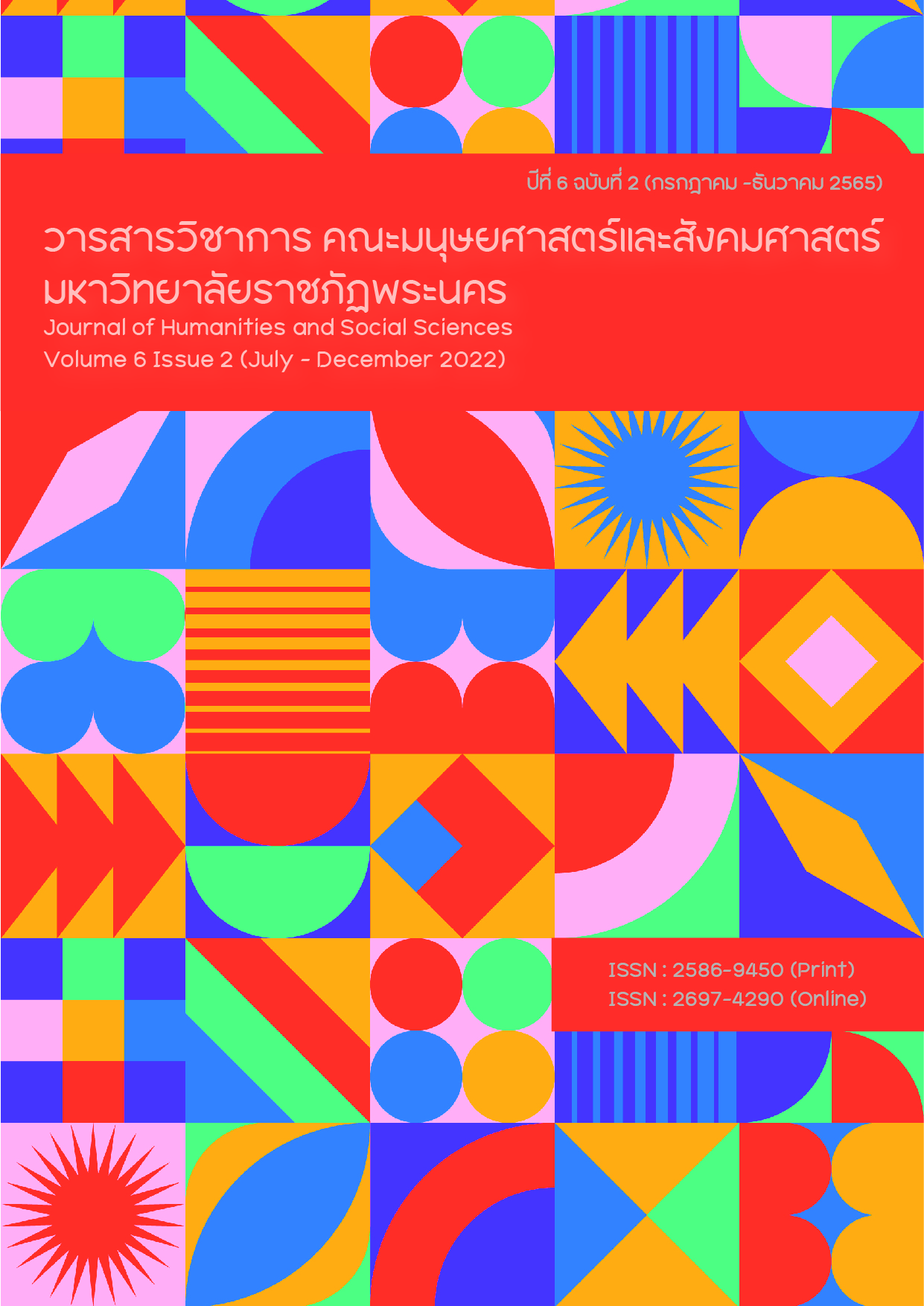การพัฒนาการการท่องเที่ยวเชิงนิเวศและเชิงสุขภาพของวิสากิจชุมชนในจังหวัดระนอง : ศึกษากรณีชุมชนบ้านหาดส้มแป้น
Main Article Content
บทคัดย่อ
บทความวิจัยนี้ มีวัตถุประสงค์ (1) เพื่อประเมินศักยภาพของการจัดรูปแบบการท่องเที่ยวเชิงนิเวศและเชิงสุขภาพของวิสาหกิจชุมชนในจังหวัดระนอง (2) ประเมินศักยภาพความพร้อมของสิ่งอำนวยความสะดวกของแหล่งท่องเที่ยวของวิสาหกิจชุมชน โดยใช้ระเบียบวิธีการวิจัยเชิงคุณภาพด้วยการสัมภาษณ์เชิงลึก (Inadept Interview) ผู้ให้ข้อมูลสำคัญซึ่งเป็นเครือข่ายวิสาหกิจชุมชน จำนวน 17 คน
ผลการวิจัย พบว่า สภาพที่ตั้งมีแหล่งท่องเที่ยวเชิงนิเวศน์และเชิงสุขภาพมีความเป็นธรรมชาติเหมาะสมกับการส่งเสริมกและพัฒนาเป็นแหล่งท่องเที่ยวที่สำคัญ โดยมีแหล่งท่องเที่ยวที่โดดเด่นคือเรียนการร่อนแร การล่องแพ อุตสาหกรรมทำเซรามิค ซึ่งมีสิ่งอำนวยความสะดวกในการให้การบริการ ได้แก่ ที่พักแบบโอมสเตย์แต่ยังมีไม่มากพอ การคมนามคมทางรถยนต์หรือรถประจำทางที่สะดวก การติดต่อสื่อสารทางอินเตอร์และโทรศัพท์ นอกจากนี้ยัง พบว่า การรวมกลุ่มการจัดการท่องเที่ยวบ้านหาดส้มแป้นภายใต้การนำของคนรุ่นใหม่และต่อมาได้พัฒนาโครงสร้างกรรมการเป็นหมู่บ้าน CIV นับว่าเป็นชุมชนที่เห็นความสำคัญของการท่องเที่ยวอันเป็นแหล่งที่สร้างรายได้ให้กับชุมชนอย่างยั่งยืนสะท้อนถึงการมีส่วนร่วมของชุมชนอย่างแท้จริงในการคิด ร่วมทำ ร่วมตัดสินใจ ร่วมรับผิดชอบ และร่วมรับประโยชน์ ประการสำคัญสมาชิกของชุมชนต่างตระหนักรู้ถึงความร่วมมือในการพัฒนาชุมชนให้มีความเจริญภายใต้ความเปลี่ยนแปลงที่ไม่ส่งผลกระทบต่อสภาพแวดล้อมธรรมชาติและวัฒนธรรมอันดีงามของชุมชน ดังนั้น จึงประเมินได้ว่าศักยภาพของการจัดการท่องเที่ยวเชิงนิเวศและเชิงสุขภาพของชุมชนบ้านหาดส้มแป้นมีความพร้อมในการให้บริการการท่องเที่ยวในจังหวัดระนองได้อย่างแท้จริง ส่วนการประชาสัมพันธ์พบว่ายังไม่กว้างขวางมากเพียงพอ
ข้อเสนอแนะ : ชุมชนการท่องเที่ยวควรมีการฝึกอบรมคนรุ่นใหม่ให้เห็นความสำคัญของการท่องเที่ยวของท้องถิ่นเพื่อรับช่วงในการพัฒนาท้องอถิ่นให้มีความเจริญที่ยั่งยืน รวมทั้งการประชาสัมพันธ์ในเชิงรุกให้กว้างขวางมากยิ่งขึ้น
Article Details
เอกสารอ้างอิง
Aran Boonchai and Jintana Tansarawiputh. (2003). Health tourism, a new selling point
of Thai tourism, Economic and Social Journal 40.(4): 22-23.
Benchamas Na Thongkaew, Amnat Raksapol, Juthamas Pengkona and Boonsilp
Chittapraphan. (2017) Potential and development guidelines Assessing the
potential of tourism resources and prepare guidelines
Tourism Development, Khanthuli Sub-district, Tha Chana District, Surat Thani
Boonlert Chittangwattana. (1999) Sustainable Tourism Development in Chiang Mai
Province: Faculty of Humanities Chiang Mai University.
Boonyaphak, Wiwatchai. (2007).TheImpactofTourism Industry in Cultural
Heritage.Tourism Journal, 4 (October), 31–38.
Chathupoom, (n.d.) Assessment theory, Copies of documents Faculty of Education
Khon Kaen Universit.
Dictionary Webster's Third New International Dictionary Meriam Webster. INC.,
Publisher, Springfield, Massachusetts, U.S.A.
Government Gazette, Volume 135, Section 82 A. National Strategy Announcement
-2037, dated 13. October 2018.
Global Wellness Institute. (2014). Global Spa & Wellness Economy Monitor. New
York:Global Wellness Institute. (pp.13–45)
Rossi, P.H. & Freeman H.E. (1982). Evaluation: A systematica approach. Beverly Hill,
California: Sage
Juthamas Chaisorn (1993). Study of the potential of tourist attractions for tourism
development in the province. Mae Hong Son. Thesis, Srinakharinwirot
Prasarnmit. University,
kanyanat Phokhiri. (2017). Cooperation Management in Community Based Tourism,
Case Study, Baan Haad Sompan, Ranong Province.: Master of Arts thesis
Silpakorn University.
Kanlaya Sawangkong. (2016). Survey of the potential of natural tourist attractions in
Saraburi Province. term paper: Graduate Business University.
Komsit Kieanwatana.(2518). Situations and Trends of World and Thailand Health
Tourism. Journal J. Cult. Approach, Vol.19, pp.78-87.
Longman. (1987) Dictionary of Contemporary. English. Harlow: Longman Press.
Ministry of Tourism and Sports. (2014). Tourism Quality Standards Assessment Guide
Natural way. Bangkok: Veterans Organization.
Ministry of Tourism and Sports. (n.d.) Report on the Vision of Thai Tourism
, Bangkok: n,p.
Namkwan Wongpratoom et al.(2018). Assessing the potential of tourist attractions to
promote tourism Agriculture, Wawee Village, Chiang Rai Province. Dusit
Thani College Journal Vol. 12 No. 2,May -August 2018, pp.132-150.
Neufeldt, Victoria (1990). Webster’s New World Dictionary. New York: A Time Warner
Company
Nutprawee Likitsaran.(2019). Potential tourist attractions of Phichit Province.
academic articles, journals Administration and Tourism Authority of Thailand,
Vol. 14, No. 1 (January-June 2019, p.p.28-41)
Office of Small and Medium Enterprises Promotion, Ranong Province. (2008).
study report Ranong Province Health Tourism Enterprise Network.
Passakorn Juansang (2020). Assessment of Community Potential in Developing Eco-
Tourism and Culture. Case Study of Ban Tha Long Community. Ubon
Ratchathani Province and Ban Tha Wat Community Sakon Nakhon
Province, Thesis, Urban Development Planning and Environment Program
Silpakorn University.
Payom Thammabutr. (2003). Documents for teaching and learning principles of
ecotourism. Bangkok: Srinakharinwirot University Ecotourism Development
Institute Province. Research journal for Spatial Development, Vol. 9, No. 2, p.p
-121.
Ranong Provincial Tourism Office, information on tourist attractions in Ranong
Province. (Retrieved from https://ranong.mots.go.th/)
Sairung, W. (2011). Guideline For Development Cultural Tourism in Cherng Tha
Temple Floating Market Lopburi Province. Independent Study, Faculty of
Management Science, Khon Kaen University.
Scriven, M. (1967). Evaluation Methodology, in RW Tyler, RM Gagne, & M. Scriven (Eds.),
Perspectives of Curriculum Evaluation Chicago, pp. 39-83.
Singsaktrakul, Parichat., & Sermkarndee, Patcharin (2013). The Study of Potentiality
and Conservation Tourism Development Approach of Baan Thung-
Maprang, Kuan Doan District and Baan Ton-Panan, Kuan Kalong District
in Satun Province. Suddhiparitad Journal, 27(83), 97-112
Sirichanya Prabhanakit (2010) Assessing the potential of tourist attractions in Muang
District, Trat Province. to create an ecotourism route, Thesis in Planning
and Managementenvironmental tourism graduate school Srinakharinwirot
University.
Sirichai Kanchanawasi. (2002) Theory of assessment. 3rd edition. Bangkok :
Chulalongkorn university. Press.
Suwimol Vongvanich and Nongluck Wiratchai. (2001). Thesis Advisory Guidelines.
Bangkok: CenterTextbooks and academic documents Faculty of Education,
Chulalongkorn University
Touchchaya Songittisuk and Natthanuch Chantavimol. (2020). Assessment of the
potential of tourist attractions.Ecology from the perspective of tourists, a
case study of Mae Sot District, Tak Province. Thesis. Hospitality and Tourism
Industry Management Bangkok University.
UNWTO. Strengthening tourism for peace. Ten searched from https://www-unwto-
org.translate.goog/
Wanna Wongwanich. (2003). Geography of tourism. 2nd Edition. Bangkok: Thammasat
University
Warat Mathayombut,(2009). Model of tourism management in Chiang Mai Province.
Ph.D.Department of Management Science. graduate school, Maejo University.
Wiwatchai Boonyaphak. (1986). Concept of the potential of tourist attractions. The
impact of Tourism industry to the cultural heritage. Travel brochure, 40-42.


